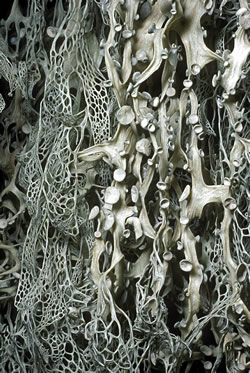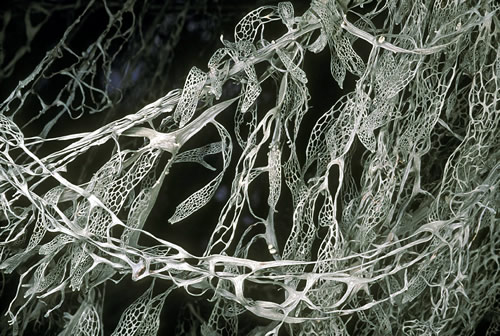California Lace Lichen
Shawna Martinez
Biology Instructor, Sierra College
Lichens are the essence of wildness
-Irwin Brodo, Lichens of North America

Thanks to Founding member of the California Lichen Society, Janet Doell, California State Assembly member, Marc Levine, and California State Governor, Jerry Brown, the Lace Lichen (Ramalina menziesii) is one of our newer State symbols. It was designated as our State Lichen on January 1, 2016. While it is more common along the coast from Alaska to Baja, California where moisture plays a more influencing role, it can be found outside of this natural distribution in four central Sierra Nevada counties.
Lichens are commonly confused with mosses and this one is no exception. Often called “Spanish Moss”, this species is not related to the “Spanish Moss” that grows in the Southwestern United States. The common name Spanish Moss refers to the flowering plant Tillandsia usneoides, a bromeliad related to pineapples. Lichens are also not related to mosses whatsoever as they are not true plants. Instead, lichens are an intriguing combination (symbiosis) of fungus, (mycobiont) and algae or cyanobacteria (photobiont). They are scientifically named after their fungal counterpart.
A Parasite?
Although lichens have been characterized previously as a mutualistic relationship between these organisms, it is now believed that lichens may represent more of a parasitic relationship—where the fungus is parasitizing and holding hostage the algae or cyanobacteria. Regardless, this association between very different organisms has probably existed for many millions of years—successfully! “A marriage on the rocks that works!”
The name Ramalina is from Latin, which translates to “thread-like branches”. This is an apt description for this beautiful lichen. Lace lichen (Ramalina menziesii) is an elongated, hanging (up to 3 feet or 1 meter) lichen with a patterned netted structure. It is pale yellowish-green, but when wet turns gray to nearly chartreuse. Lichens in general typically come in three shapes: crustose (crusty—like an old coat of paint), foliose (leafy), and fruticose (divided or fuzzy). The Lace lichen is considered a fruticose lichen due to its large hanging structure—kind of like an upside-down shrub. It is classified with the cup fungi (the Ascomycetes) and occasionally will have reproductive structures indicative of the group.
Lace lichen makes its habitat as a commensal (attached to, but not parasitizing) on oaks and conifers, primarily on deciduous trees to take advantage of the winter sunlight. The reproductive structures called soredia (combined bits of fungus and algae) travel in the wind for distribution and also may be dispersed by birds such as hummingbirds, bushtits, and orioles as they gather these lichens for their nests.
Native American Usage
Ramalina menziesii was used in a variety of ways by tribes of Native Americans along the coast, and possibly throughout the Sierra. In a compilation put together by Sylvia Sharnoff in 2003, Lace Lichen was used by the Kawaiisu because of its “magical” properties. They would use it to ward off thunder and lightning by throwing it in fire. They would also throw it in water to bring on rain. The Kashaya Pomo were known to use Lace Lichen as absorbent filler for baby diapers as well as other sanitary uses.
This stunningly beautiful lichen plays a big role in the ecosystem as all lichens do. Lichens in general are known for their sensitivity to air pollution and climate and are being used throughout California to monitor air quality and climate change.
Dust particles blowing on the wind collect on the surface of these lichens during the dry summer months and the lichen appears all but dead. As soon as the rainy season commences, Ramalina starts to photosynthesize immediately. Interestingly, Ramalina assists the host oak or conifer by dripping necessary collected nutrients to the forest floor that can then, in turn, be picked up by the roots of the host plant.
In one study, it was determined that the amount of nitrogen doubled by the presence of Ramalina in oaks. Because these lichens are so extensively rich in nitrogen, they are also favored foodstuff of squirrels, deer, and rabbits. In oak woodlands, where Ramalina flourishes, a “browse-line” can readily be seen where animals reach up to browse this lichen from the trees.

A Collector of Sulfur
Ramalina menziesii and many other lichens have a unique ability to sequester sulfur from the atmosphere through their photosynthetic processes. This sequestration figures prominently in the overall atmospheric absorption of sulfur.
Lawrence Janeway of the Chico State University Herbarium states:
“The California Lichen Society (CALS) was instrumental in getting the state lichen passed. Shelly Benson, CALS president, explained that lace lichen has three strong qualities that made it an ideal candidate. First, it is easy to recognize even by those not very well acquainted with lichens. Second, it is common throughout much of California—growing along the coast from the northern to the southern borders and up to 130 miles inland. Lastly, and most significantly, it is an amazingly beautiful lichen.
I see this as an important step in increasing public awareness of lichens. Lichens are found all around us, growing on almost any surface and found in nearly every habitat; yet, they are overlooked by most people" said Benson. Lichens are composite entities—composed of two or more different organisms. In its simplest form, the lichen is made up of a fungus and an alga. These two partners live intertwined in a symbiotic relationship. The fungus provides a structural home that protects the algal cells. In return, the alga feeds the fungus by producing sugars through photosynthesis.
While small in stature, lichens play a big role in the ecosystem. With nearly 1,900 species of lichens in California, they contribute to our region’s rich biological diversity. Lichens are known for their sensitivity to air pollution and climate, and are being used across California to monitor air quality and climate change. Lichens are an integral part of the living soil crusts that stabilize desert soils. Additionally, animals use lichens for food, nesting material, and camouflage. Humans have found several uses for lichens as well. Possibly the most promising is in medicine. Lichen extracts are being studied for their antibacterial properties.
Calling attention to lichens by recognizing one of them as the California State Lichen creates an opportunity for us to learn about and celebrate the things that make California special.”
Resources
- Knops, J. M. H., T. H. Nash III and W. H. Schlesinger. 1996. The Influence of epiphytic lichens on the nutrient cycling of an oak woodland. Ecological Monographs 66:159-179.
- Rundel, P.W. 1974. Water relations and morphological variations in Ramalina menziesii Tayl. Bryologist 77:23-32.
- Sharnoff, Sylvia Duran (comp.). 2003. “Biographical Database of the Human Uses of Lichens.” [On-line]. http://www.lichen.com/biology.html [October 8, 2003].
- Benson, Shelly. 2016. President, California Lichen Society. Personal communication.
- Special thanks to Stephen Sharnoff for his superb photographs of our state lichen. His website (with lots of lichen photos and many others) is http://www.sharnoffphotos.com/index.html
- Sharnoff’s book on California lichens was published by Yale University.
http://yalebooks.com/search/node/Lichens%20of%20North%20America - For more information about California’s state lichen visit:
http://californialichens.org/state-lichen/ - For more information about the California Lichen Society, visit their web site at:
http://californialichens.org/
"Dedicated to promoting the appreciation, preservation, and study of California lichens."
